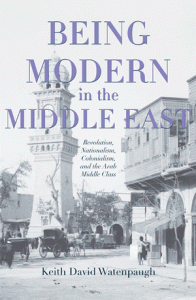|
Reviewed by Michael Kreutz, Ph.D., University of Erfurt Can one have nationalism without nationalists? This is the question Keith David Watenpaugh poses in his book Being Modern in the Middle East: Revolution, Nationalism, Colonialism, and the Arab Middle Class, an in-depth examination of the circumstances of Arab middle-class modernism at the close of the Ottoman Empire. Focusing on the city of Aleppo in Northern Syria, Watenpaugh provides a clear-cut survey of what makes a modern society in time of revolution. In fact, it was a revolution, when the Ottoman Constitution was set up for the first time in 1876 and initiated a process of societal modernization. Under this aspect, Aleppo serves as a vivid example to understanding the emergence of a middle-class which soon became well connected with other parts of the empire. Throughout the text, Watenpaugh prefers the use of the term “Eastern Mediterranean” over that of the “Middle East,” a larger entity shaped by the boundaries of the Ottoman Empire and reaching into the European continent where voluntary organizations created social space with coffeehouses, newspapers, clubs, and debating societies, adapting new communicative technologies and bypassing the traditional elite. Watenpaugh points out how a new public sphere was brought into being and “businessmen, bureaucrats, and liberal professionals behaved as a group and engaged in a form of political discourse reminiscent of similar activities in Europe.” Journalism as a new profession entered the stage and became the most outstanding corollary of a new urban political culture. What makes the book especially thrilling is the contextualization with Europe and other continents: “Like the middle class of Paris, London, New York, and Berlin, the “second-wave” middle class of Shanghai, Aleppo, São Paulo, and Lucknow self-consiously and purposefully manifested similar organizational forms and styles of communicative and political action.” Bernard Lewis once reminded us of the darker side of this phenomenon when he pointed to the fact that Middle Eastern fascist movements like the former Baath party in Iraq were chiefly an export from Europe. Watenpaugh dedicates a complete chapter to this and describes how, in a city like Aleppo, a middle-class fascism in the 1930’s became popular by to some extent by mimicking German and Italian models which were identitfied with being modern. Again, the Syrian “Steel Shirts” (qumsan hadidiyya) found a parallel in similar movements not only in Western Europe and other parts of the Arab World (e.g. the “Green Shirts” in Egypt), but also in the Balkans and South America as well. And there is much more to this book than that. Certain aspects, based on an elaborative research in national archives and historical magazines make this book especially important. For instance, the statement that Sherif Husayn’s Arab Revolt (1916-1918) “was ignored for the most part, or, when acknowledged, greeted with a great deal of skepticism by the Arabic-speaking inhabitants of the empire” is perfectly in line with both Efraim Karsh’s 2004 book Empires of the Sand which argues that the so-called “Arab Revolt” was amply a myth invented by the late Christian-Arab historiographer George Antonius in his popular 1938 book The Arab Awakening, as well as with Dalal Arsuzi-Elamir’s 2001 study on Arab nationalism in Syria which draws a similar conclusion, although Watenpaugh refers to none of them. In the same fashion, Watenpaugh convincingly illustrates that life under the presence of an imperial power was not simply subject to mere supression, showing how a significant portion of the local inhabitants cooperated with the French and thus used to practice what he calls the “colonial contract” which, again, corroborates another survey of the aformentioned Efraim Karsh, i.e. his 2006 “Islamic Imperialism.” This is surely not the Saidian view of the Middle East. Watenpaugh eschews to regard the local community as nothing but subjects to colonization, for “a focus on resistance essentializes the colonized.” The author does not stop here but eagerly tries to draft a theory of the middle-class. One of its specific phenomenons is the re-writing of history and the introduction of imagined national communities. When the editor of the Ottoman almanac Sâlnâme sought to find an Arab history distinct from a Muslim one, he had to resort to European sources and consequently introduced the logic of the nation into his historiography—a logic that would run of itself. The theoretical approach which is aimed at developing a theory of the middle-class makes it useful not only for scholars of Middle Eastern Studies, but also for sociologists alike. Watenpaugh provides an insightful, comprehensive, and well-written survey of what made modernity in the Eastern Mediterranean. |


 Being Modern in the Middle East: Revolution, Nationalism, Colonialism, and the Arab Middle Class
Being Modern in the Middle East: Revolution, Nationalism, Colonialism, and the Arab Middle Class